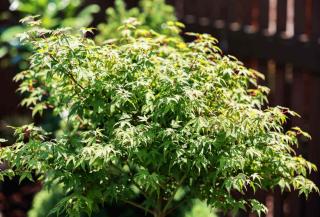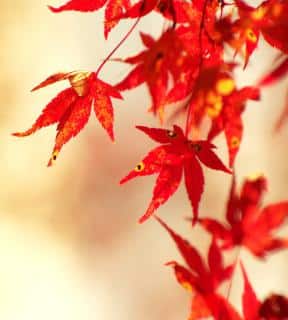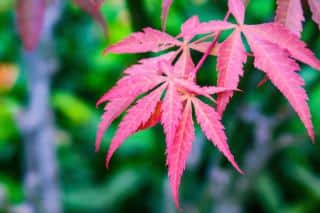

Colorful to the point of being flamboyant, Japanese maple is a very beautiful shrub thanks to the color and delicate shape of its leaves.
Key Japanese maple facts
Name – Acer japonicum
Family – Sapindaceae
Type – tree
Height – 26 to 32 feet (8 to 10 meters)
Exposure – part sun
Soil – ordinary, well drained
Foliage – deciduous
Japanese Maple is planted in fall, but can also be planted in spring when purchased in a container.
 Japanese maple likes places that are partly shaded.
Japanese maple likes places that are partly shaded.Growing Japanese maple in pots is more than just perfectly possible: this is an ideal shrub for the purpose.
Both in pots and in the ground, support the tree’s growth with mulch at the base of the tree to retain soil moisture.
If properly settled in and with proper growing conditions, Japanese maple is easy to care for.
The most common mistake we’re aware of is about watering.
 It isn’t really recommended to prune it.
It isn’t really recommended to prune it.
Your Japanese maple doesn’t like pruning, and only the oldest specimens will need some trimming to remain small.
If pruning must be done, then perform it in winter, whenever the weather isn’t freezing. Never prune anytime other than between November and March.
Japanese maple is a favorite host of aphids. Those little green or black bugs can colonize leaves and weaken your tree.
If you notice that some Japanese maple branches turn black, cut them off at the base and destroy them.
Indeed, many maple trees are infected by a disease called Verticillium which is a fungus capable of devastating an entire tree within months.
As soon as you see the disease on your tree, burn the dry branches. If the spots are only on the leaves, it may not be the same disease (black spots on leaves are harmless).
 As its name shows, this maple is native to Japan. Indeed, it comes from the underbrush of Japanese forests. Even though they’re in the same family as common maple, they can’t cross-pollinate because they’re too far apart genetically.
As its name shows, this maple is native to Japan. Indeed, it comes from the underbrush of Japanese forests. Even though they’re in the same family as common maple, they can’t cross-pollinate because they’re too far apart genetically.
It has fiery hued foliage in fall, and a true festival of colors starts at the end of summer.
It’s common practice to group together under the title “Japanese maple”, all types of maple coming from that country. Included are Acer japonicum, Acer shirasawanum and Acer palmatum.
It loves acidic soil. A blend of plant-enriched earth, soil mix and heath soil will suit it perfectly!
©Liliya Trott©Dan/AdobeStock
Hi Gaspard, thanks so much for your reply + the great tips you sent me, I’m a lot wiser now, so I can go ahead + plant my maple properly. Regarding the ‘market garden’ in my email address, haha – no, I don’t have one myself but my dad did years ago, he also served in the British Army in WW2 as an RSM rank on D-Day in 1944. He survived + came home after the war ended, the secret code word for D-Day was – Market Garden !. I am so proud of my dad for what he did for his country, he was also a great gardener + taught me a lot when I was a kid, dad passed away in 1997, I dedicated my email address to him. Many thanks for your help my friend, best regards, Steve
Hi, I’ve bought a potted Acer recently + plan to plant in the garden soon, should I add rotted twigs in with the bag of Ericaceous compost for better drainage or will it benefit if I add grit or any other. Thanks
Hi Steve, for sure you can add twigs that are nearly rotting out at the bottom of the planting hole. Don’t add too much or the ground will sink lower than normal within a couple years.
Two ways to ensure this doesn’t happen:
– dig the hole, layer the twigs at the bottom, add compost for Ericaceae/heath + garden soil and stamp it down. You can even let the hole sit as is for a week or two, and stamp it down again.
– when finally planting the Japanese maple, stamp it down one more time, and then plant the tree at such a height that the mound or root crown is higher than the surrounding soil. How much higher depends on the thickness of the layer of twigs. You have to assume the layer of twigs will disappear entirely in time.
Having the twigs rot away will definitely work wonders for your Acer, both in terms of drainage and nutrients. It’s exactly the concept behind using Ramial Chipped Wood, too.
No need to add sand or grit if you go with the twigs, even in heavy soil.